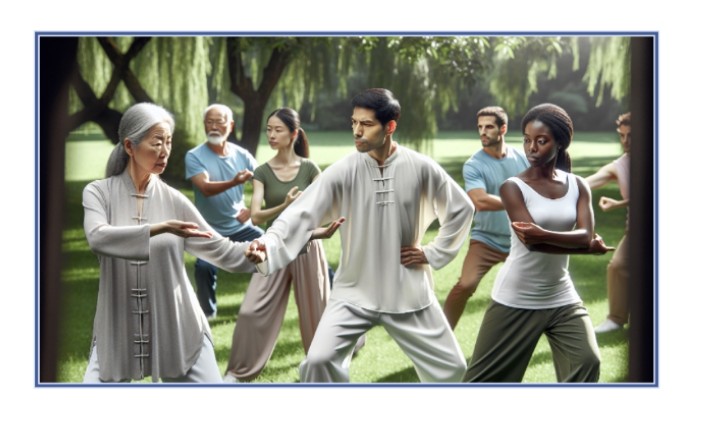Tai chi, an ancient Chinese martial art, has gained popularity worldwide as a gentle and effective form of exercise and meditation. This low-impact practice offers numerous benefits for both physical and mental well-being. In this comprehensive guide, we’ll explore four tai chi meditation practices that you can learn through tai chi lessons.
Introduction to Tai Chi
Tai chi, also known as tai chi chuan, is a traditional Chinese practice that combines slow, graceful movements with deep breathing and mindfulness. It is based on the principles of yin and yang, the opposing yet complementary forces that are believed to exist in all aspects of life.
The Origins of Tai Chi
Tai chi has its roots in ancient China, where it was developed as a martial art. Over time, it evolved into a holistic practice that emphasizes health, balance, and inner peace. Today, tai chi is practiced by millions of people around the world for its numerous benefits.
The Principles of Tai Chi
The principles of tai chi include:
- Relaxation
- Mindfulness
- Slow, continuous movements
- Proper breathing
- Balance and alignment
By adhering to these principles, practitioners can cultivate a sense of inner peace, improve their physical health, and enhance their overall well-being.
The Four Tai Chi Meditation Practices
Tai chi offers four distinct meditation practices that can be learned through tai chi lessons. Each practice focuses on different aspects of mindfulness and offers unique benefits.
Standing Meditation
Also known as Zhan Zhuang, standing meditation is a foundational practice in tai chi. It involves standing in a specific posture, with the feet shoulder-width apart and the knees slightly bent, while focusing on deep breathing and relaxation.
Benefits of Standing Meditation
- Improves posture and balance
- Strengthens the legs and core muscles
- Enhances body awareness
- Reduces stress and anxiety
How to Practice Standing Meditation
- Stand with your feet shoulder-width apart, knees slightly bent.
- Keep your spine straight and your shoulders relaxed.
- Breathe deeply and evenly, focusing on the sensation of the breath moving through your body.
- Maintain this posture for 5-10 minutes, gradually increasing the duration as you become more comfortable.
Sitting Meditation
Sitting meditation, or Jing Zuo, is another essential practice in tai chi. It involves sitting in a comfortable position, either on a cushion or a chair, and focusing on the breath and the present moment.
Benefits of Sitting Meditation
- Calms the mind and reduces stress
- Improves concentration and focus
- Enhances self-awareness
- Promotes relaxation and inner peace
How to Practice Sitting Meditation
- Sit comfortably on a cushion or a chair, with your spine straight and your shoulders relaxed.
- Close your eyes or keep them slightly open, gazing downward.
- Focus on your breath, observing the sensation of the air moving in and out of your body.
- If your mind wanders, gently bring your attention back to your breath.
- Continue this practice for 10-20 minutes, gradually increasing the duration as you become more comfortable.
Walking Meditation
Walking meditation, or Xing Gong, is a dynamic practice that combines slow, mindful walking with deep breathing and awareness of the body’s movements.
Benefits of Walking Meditation
- Improves balance and coordination
- Increases body awareness
- Reduces stress and anxiety
- Promotes a sense of calm and inner peace
How to Practice Walking Meditation
- Find a quiet, open space where you can walk comfortably.
- Stand with your feet shoulder-width apart, arms relaxed at your sides.
- Take a slow, deliberate step forward, focusing on the sensation of your foot making contact with the ground.
- Continue walking slowly, synchronizing your breath with your steps.
- If your mind wanders, gently bring your attention back to your breath and the sensation of walking.
- Practice walking meditation for 10-20 minutes, gradually increasing the duration as you become more comfortable.
Tai Chi Form Meditation
Tai chi form meditation involves practicing a series of slow, continuous movements that flow seamlessly from one to another. Each movement is synchronized with deep breathing and mindfulness.
Benefits of Tai Chi Form Meditation
- Improves flexibility, balance, and coordination
- Strengthens the muscles and joints
- Reduces stress and anxiety
- Enhances mental clarity and focus
How to Practice Tai Chi Form Meditation
- Learn the basic tai chi forms from a qualified instructor or through tai chi lessons.
- Practice each form slowly and mindfully, focusing on your breath and the sensations in your body.
- Pay attention to your alignment and posture, ensuring that your movements are smooth and continuous.
- Repeat each form several times, gradually increasing the duration and complexity of your practice.
Benefits of Tai Chi Meditation
Tai chi meditation offers numerous benefits for both physical and mental well-being, including:
| Physical Benefits | Mental Benefits |
| Improved balance and coordination | Reduced stress and anxiety |
| Increased flexibility and range of motion | Enhanced mental clarity and focus |
| Strengthened muscles and joints | Greater self-awareness and inner peace |
| Improved cardiovascular health | Better sleep quality |
| Enhanced immune function | Increased resilience and emotional well-being |
How to Learn Tai Chi
To learn tai chi and incorporate these meditation practices into your daily life, consider the following options:
Attend Tai Chi Lessons
Attending in-person tai chi lessons with a qualified instructor is one of the best ways to learn the proper techniques and forms. Look for classes at local community centers, gyms, or dedicated tai chi studios.
Online Tai Chi Courses
If you prefer to learn at your own pace or don’t have access to in-person lessons, online tai chi courses can be a great alternative. Many websites and apps offer video tutorials and guided practices for beginners and advanced practitioners alike.
Practice Regularly
Consistency is key when it comes to learning tai chi and experiencing its benefits. Aim to practice tai chi meditation for at least 15-20 minutes per day, gradually increasing the duration and complexity of your practice as you become more comfortable.
Join a Tai Chi Community
Connecting with other tai chi practitioners can provide support, motivation, and opportunities for learning and growth. Consider joining a local tai chi group or participating in online forums and communities dedicated to tai chi and meditation.
Conclusion
Tai chi meditation is a powerful practice that can transform your physical, mental, and emotional well-being. By exploring the four tai chi meditation practices outlined in this guide – standing meditation, sitting meditation, walking meditation, and tai chi form meditation – you can cultivate greater awareness, reduce stress, and promote inner peace.
Whether you choose to attend in-person tai chi lessons or learn through online resources, consistency and dedication are essential for reaping the full benefits of this ancient practice. By incorporating tai chi meditation into your daily life, you can experience profound improvements in your health, happiness, and overall quality of life.


